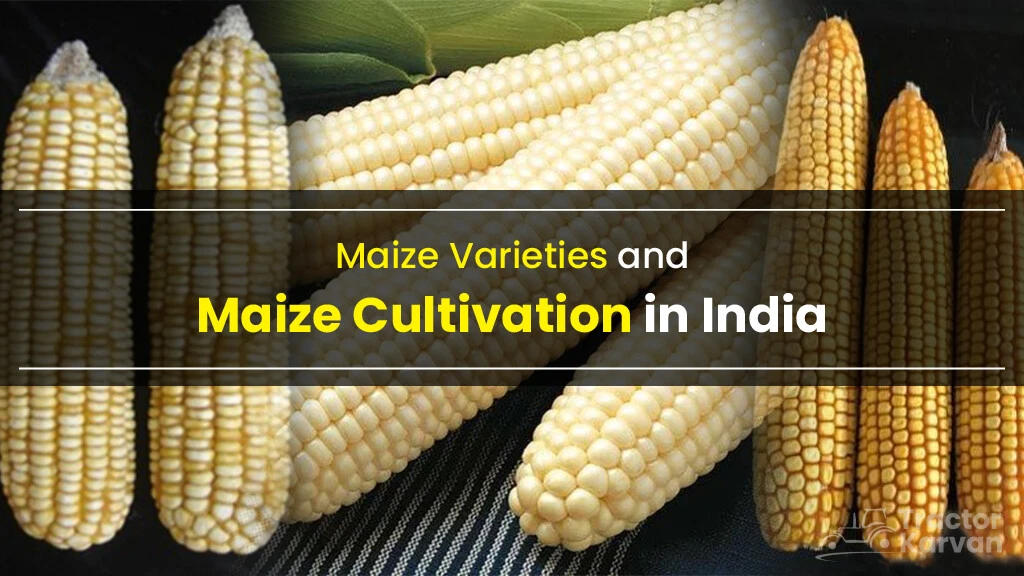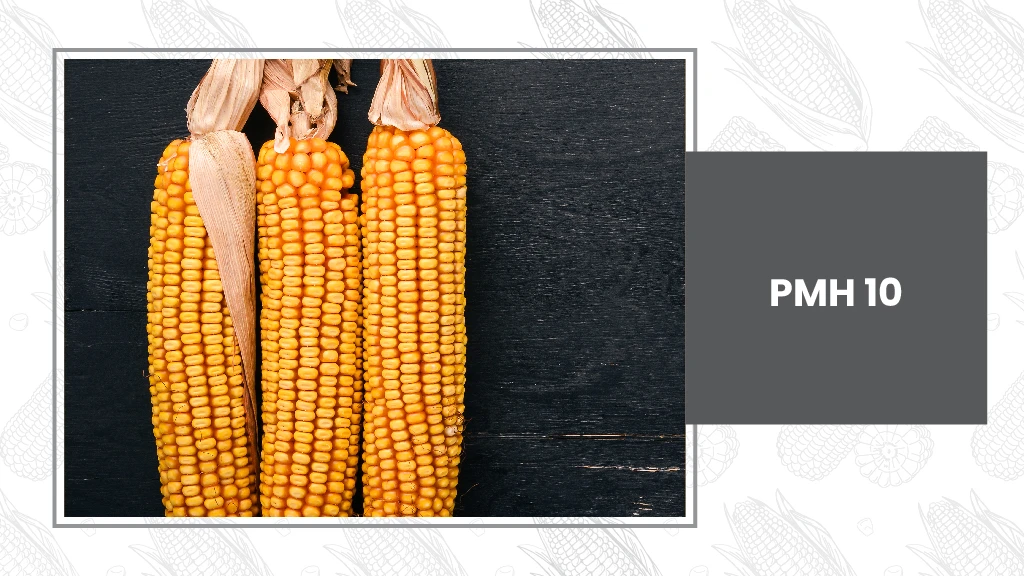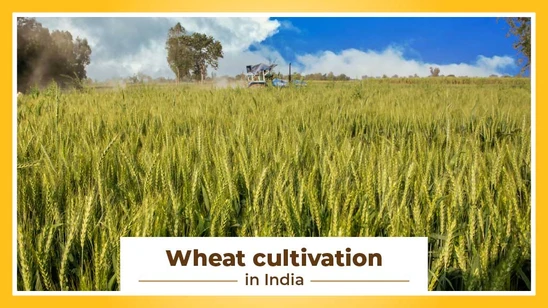Varieties of Maize Crop and Maize Cultivation in India

Table of Contents
- Introduction
- Varieties of Maize Crop in India
- Tabular Representation of Top Maize Varieties
- Climate, Soil and Season for Maize Cultivation in India
- Things to Consider for Maize Cultivation in India
- Conclusion
Introduction
Maize, also known as corn, is one of India's most important cereal crops. It is the third most important crop in India after rice and wheat. Karnataka is the top maize producing state in India.
Maize is a versatile crop with a wide range of uses, including as a staple food, livestock feed, and raw material for various industrial products. Maize plant cultivation in India has a rich history, with various regions producing distinct varieties tailored to their specific agroclimatic conditions.
Varieties of Maize Crop in India
In India, many varieties of maize crop are cultivated depending upon the agro-climatic conditions. The important maize varieties are MM 9344 (DMH 192), Gujarat Anand White Maize Hybrid -2, and Pusa HM-9 improved, among others. Let us see some of the prominent varieties in brief.
MM 9344 (DMH 192)
- MM 9344, also known as DMH 192, is a popular maize crop hybrid variety in India. It is known for its high yield potential and adaptability to various agroclimatic zones.
- This variety is widely cultivated in states like Karnataka, Andhra Pradesh, Maharashtra, Tamil Nadu, and Telangana.
- MM 9344 exhibits excellent moisture stress and pest tolerance, making it a preferred choice for many farmers.
- Its uniform grain size and good cob length make it a valuable maize variety for both food and feed purposes.
Gujarat Anand White Maize Hybrid-2 (GAWMH-2)

- Gujarat Anand White Maize Hybrid-2, often abbreviated as GAWMH-2, is a white maize hybrid variety developed specifically for the Gujarat region.
- This variety is known for its high yield potential and resistance to diseases.
- GAWMH-2 is prized for its large, attractive cobs and uniform grain size, making it suitable for fresh consumption and processing into products like maize flour and cornflakes.
- Farmers in Gujarat have found success with this corn crop variety due to its adaptability to local growing conditions.
Pusa HM-9 Improved (AQH-9)

- Pusa HM-9 Improved, or AQH-9, is a maize hybrid developed by the Indian Agricultural Research Institute (IARI) in Delhi.
- It is known for its high yield potential, good grain quality, and adaptability to various agroclimatic zones.
- This variety is preferred by farmers in northern India, especially in states like Jharkhand, Bihar, West Bengal, and Uttar Pradesh.
- Pusa HM-9 Improved has good resistance to major diseases and pests, ensuring a reliable harvest. Its grains are suitable for both food and livestock feed, making it a versatile choice for farmers.
Bisco X 5129
- Bisco X 5129 is a maize hybrid variety that has recently gained popularity. It is known for its high yield potential and adaptability to diverse agroclimatic conditions.
- Farmers prefer this corn crop variety in states like Andhra Pradesh and Maharashtra.
- Bisco X 5129 is valued for its early maturity, which allows farmers to harvest maize crops in a shorter duration.
- Its resistance to diseases and lodging makes it a reliable choice for cultivation. The grains are suitable for both food and feed purposes, contributing to their popularity.
PMH 10 (Hybrid)

- PMH 10, a hybrid maize crop variety, is another significant contributor to maize cultivation in India.
- It is valued for its high yield potential and adaptability to diverse agroclimatic zones across the country.
- PMH 10 is known for its disease resistance, which is essential for ensuring a successful maize crop.
- This hybrid variety is cultivated in Punjab, where it has consistently delivered good yields. The grains from PMH 10 are suitable for various uses, including food, fodder, and industrial applications.
Tabular Representation of Top Maize Varieties
|
Maize Variety |
Maize Cultivating States |
|
MM 9344 (DMH 192) |
Maharashtra, Andhra Pradesh, Karnataka, Telangana, Tamil Nadu |
|
Gujarat Anand White Maize Hybrid-2 (GAWMH-2) |
Gujarat |
|
Pusa HM-9 Improved (AQH-9) |
Jharkhand, Odisha, Bihar, West Bengal, and Uttar Pradesh |
|
Bisco X 5129 |
Tamil Nadu, Karnataka, Andhra Pradesh, Maharashtra |
|
PMH 10 (Hybrid) |
Punjab |
Climate, Soil and Season for Maize Cultivation in India
Maize cultivation in India has evolved over the years, with farmers adopting modern techniques and practices to enhance yield and quality. Here are some key aspects of maize cultivation in India:
Climate for Maize Cultivation
- Maize is a warm-weather crop that requires specific moisture in the soil from the beginning.
- The optimal temperature for maize cultivation ranges from 18°C to 28°C.
- It requires minimum 5 frost free months as it is impacted by frost.
- The rainfall required for its cultivation is between 50 – 90 cm.
Soil for Maize Cultivation
- Maize can be cultivated in soils ranging from clay to loamy sand soils.
- Soil consisting of good organic matter, water holding capacity and neutral pH value are considered best for high productivity.
Maize Cultivation Season
- Maize is both a Kharif crop and Rabi crop. Maize cultivation requires good amount of rainfall followed by good amount of sunshine. Thus, the seeds are sown during June – July, September – October and January - February.
- Maize is also grown for seed production. As a result, the seeds are sown during November – December also.
Things to Consider for Maize Cultivation in India
You need to consider certain things in mind before starting the maize cultivation in India. these include, seed selection, land preparation, irrigation requirement, and disease management, among others. Let us see in brief each of the points.
- Seed Selection: Selecting the right maize variety is crucial for a successful harvest. Farmers choose varieties based on factors like agroclimatic conditions, disease resistance, and intended use (food or feed).
- Land Selection: Maize cultivation requires a land free from volunteer maize plants, which are unwanted plants grown from previous maize crops. These plants may result in genetic contamination.
- Land Preparation: Proper land preparation involves about 6- 7 ploughs to get the fine tilth. It is followed by levelling the field to create a suitable seedbed. Maize requires well-prepared soil for good root development.
- Sowing: Maize is typically sown in rows or ridges. The plant-to-plant spacing need to be 10 cm and 2 seeds per hill should be sown. Moreover, the seed should be sown at a height of 1/3rd from the bottom of the ridge.
- Irrigation: Just after sowing, the maize crop should be irrigated on 3rd or 4th day. Afterwards up to 25 – 30 days, it requires a smaller number of irrigations followed by irrigation once per week. However, the soil condition and season also should be kept in mind while irrigating the maize crop.
- Fertilization: Maize plant responds well to the application of balanced fertilizers. Soil testing can help identify the specific nutrient requirements for a particular field.
- Weed and Pest Management: Weeding and pest control are essential to prevent competition for nutrients and protect the crop from damage.
- Disease Management: Maize crop is susceptible to diseases like downy mildew and stalk rot. Choosing disease-resistant varieties and practising crop rotation can help manage these issues.
- Harvesting and Post-Harvesting: Maize is typically ready for harvest within 60 to 100 days, based on the variety, heat amount during growing and local conditions. Proper post-harvest handling, including drying and storage, is essential to preserve grain quality and prevent mould or insect infestations.
Conclusion
As the demand for maize continues to rise for food, animal feed, and industrial applications, the cultivation of high-yielding and disease-resistant varieties will remain essential to meet the nation's needs. Farmers in India must continue to receive support in terms of access to quality seeds, agricultural knowledge, and resources to maximize maize cultivation’s potential.


Related Blogs















